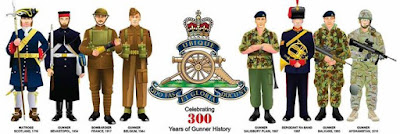Artillery Before the Formation of the Royal Artillery
The first recorded use of cannon was by Edward III at the Battle of Crecy in 1346. Henry V was recorded as using siege cannon at Harfleur in 1415.
 |
| Siege Cannon 1415 |
The use of gunpowder and cannons developed over the next two hundred years. The practice was to either assemble cannon for a particular campaign, or to emplace them in fortresses for defence. A Master Gunner would control the cannon and trained men were employed to operate the ordnance.
It was Henry VIII (King of England 1509 to 1547) who formed the first permanent Artillery force in the country. It consisted of a Master Gunner and 12 paid Gunners at the Tower of London. The practice of raising a Trayne for a particular campaign continued throughout the 16th century. During the campaign senior officers with Army commissions were in charge of artillery and engineers, administered by His Majesty's Board of Ordnance.
 |
| Tower of London 1547 |
 |
| Tudor Artillery and Gunner |
During reign of William III (1689-1702) regimental organisation developed in traynes, but it was still on a campaign basis.
 |
| Artillery Trayne |
As Britain began colonising overseas territories, to protect key ports vital to the Royal Navy, artillery garrisons were established in Nova Scotia, Gibraltar, and Minorca. The first use of mobile artillery was in the Battle of Blenheim in 1704 when the Duke of Marlborough led a coalition force to defeat French and Bavarian troops.
The formation of traynes when they required was economical, but inefficient when required at short notice as happened in 1715 with the Jacobite Rebellion. James Edward Stuart attempted to seize the thrones of England, Ireland and Scotland for the exiled Stuarts. The government sent forces north to quell the rebellion, mobilising an artillery trayne. The rebellion lasted four months, the government forces suppressing the uprising, before the artillery trayne could be formed.
Formation of the Royal Artillery
Following the Jacobite Rebellion of 1715, the Duke of Marlborough, Master of the Ordnance, approached King George I to stress the importance of a critical core of retained artillery.
On May 26th 1716 George I issued a Royal Warrant creating a permanent artillery consisting of two companies formed in Woolwich.
 |
| Royal Warrant of 26th May 1716 authorising the formation of the Royal Artillery |
History of the Royal Artillery
 |
| Tercentenary of the Royal Artillery Kings Troop RHA fire Royal Salute |
























